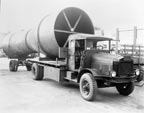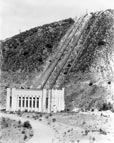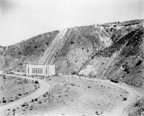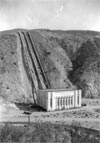 Barcode:
Barcode:1000111
Siphon construction Subjects:
Construction
Pipes
Hills
Collection: Bledsoe Collection 1908-1933
 Barcode:
Barcode:1000111 |
Title: Siphons--Siphon Construction
Description: Siphon construction Subjects: Construction Pipes Hills Collection: Bledsoe Collection 1908-1933 |
 Barcode:
Barcode:1000475 |
Title: Owens Valley Power Plants
Description: Big Pine Power Plant 3 September, 1925 – “This is an ideal location for the Upper Plant; right over there we can located the intake for Plant No. 2 which will be farther down the canyon and that will locate Plant No. 3 in the delta just below the mouth of the canyon.” They were talking about the proper development of Big Pine Creek. The time was the summer of 1911. They were camped at the Forks of Big Pine Creek on the steep eastern slopes of the High Sierras. Above them towered the Sierras peaks 14,000 feet high – just below the crests were the snow and ice packs that give this section its renown for everlasting glaciers and constant water flow. The vision which prompted their decision was no doubt fathered by the realization that there was a close relationship between those towering peaks, the valley below, and the City of the Angels, 275 miles to the southward. Their vision included not only the proper development of power but the maximum use of the waters of the stream on the farms below; and their constant efforts and negotiations finally resulted in an agreement between the City and the Big Bear Water Users’ Association. An agreement of mutual benefit. The City was given the right to store water, provided it built the dams, and a schedule of water flow for each month was agreed upon. Built Dam at Lake No. 3 During the summer of 1921 a dam was partly built at Lake No. 2 and certain required storage thereby provided. The portion of the road built this summer of 1925, during the construction of Big Pine No. 3, looks forward to the ultimate raising of the level of the lakes and at the same time make that wonderful country accessible to the motorist. Big Pine No. 3 is now a reality. The mountains and the City have come closer together as a result of the completion of this project. This hydro-electric power is now flowing to the homes, farms and commercial centers of Owens Valley, where it renders a t cheap rates a service that is indispensable. More than that, – this power is adding in a big way to the water conservation and water development of Owens Valley directly – and the City of Los Angeles indirectly. It is the largest of six power plants on the 200-mile electric system which the City of Los Angeles owns and operates in Owens Valley. It is of especial interest that just at the time the plant was nearing completion, Mother Nature, through the vagaries of some record breaking storms, seriously crippled the Southern Sierras Power Company’s equipment that supplies some large chemical industries in the Valley, and through temporary connections Big Pine No. 3 Power Plant was able to step into the threatened power shortage and tide the Power Company over until repairs could be made. Big Pine No. 3 Power Plant is equipped with a 4,000-horsepower Pelton Water Wheel and a 4,000 K.V.A General Electric Generator which feeds into the 33,000-volt valley electric system of the Water Department through an outdoor step-up transformer station. Every possible provision has been made for the safety of men and equipment. In this power plant, whose intake is nearly a mile and a half above sea level, lightning is a nightly and almost daily visitor. The possibility of damage or interruption from this source was given special thought by the installation of the newest type of Auto Valve Lightning Arresters of the outdoor type. As much of the equipment as possible was installed outdoors and presents a pleasing part of the entire power plant setting. The building is of simple yet attractive design, reinforced concrete and fireproof in its construction, and withal it reflects credit to that first conception of location as well as to the more recent details of its construction. From the diversion dam or intake on the creek far up in the canyon, through the fish trap and the long pre-cast concrete flow line, to the steel penstock where the water shoots down more than 1,200 feet to the Power Plant, one can see every kind of difficult construction problem that can be imagined. This more then two miles of flow line and penstock was carved out of the steep mountain side under extreme difficulties. Careful preparation of construction equipment and the necessary provisions for making repairs or alterations in the field are largely responsible for the excellent showing made in completing the entire construction program within the scheduled time estimated. Too much credit cannot be given to the field forces for combating the various and sundry difficulties which are always present upon construction work. In this case, it was a race against time with the base of supplies 275 miles away and the fact added to the individual responsibilities of the men on the job. It is also to their credit that much of the work was done for less money than estimated and in some instances represented large savings over a contractor’s bid for doing the same work. At times, more than 200 men were employed, and the health of the various camps was 100 per cent, which speaks well for the cooks and the camp supervision. In carrying on the construction activities, every opportunity was given for the employment of Owens Valley residents and the few who went up from the city of Los Angeles were outspoken in their commendation of the interest displayed and the cordial treatment they received from their newly made friends in the Big Pine section. Many miles of excellent roads were built by the Department before the actual power plant construction could be started. These roads are already carrying a constantly increasing travel of autos into the glacier country at the head of Big Pine Creek. Big trees, waterfalls, beautiful lakes and permanent glaciers offer opportunity for fishing and sight-seeing which is unsurpassed in the West. The time is sure to come when this magnificent mountain country will be on the regular schedule of the traveling and camping public and when it does come, the Department of Water and Power will be given due credit for the constructive vision of its engineers in conserving and utilizing to best advantage so large a part of the natural resources on the Eastern Slope of the Sierra Nevada Mountains. Millions upon million of dollars is being spent in constructive activities in Owens Valley by the City of Los Angeles. The program of development is but started. “Rome was not built in a day.” The West was not won in a year nor a generation. As time goes by, and the far seeing vision of our leaders becomes reality, as has Big Pine No. 3, this southwest empire, from the High Sierras to the Pacific, will be one and the same family in thought, purpose and action. Subjects: Mountains Pipes Buildings Roads Collection: Bledsoe Collection 1908-1933 |
 Barcode:
Barcode:1000477 |
Title: Owens Valley Power Plants
Description: Big Pine Power Plant 3 September, 1925 – “This is an ideal location for the Upper Plant; right over there we can located the intake for Plant No. 2 which will be farther down the canyon and that will locate Plant No. 3 in the delta just below the mouth of the canyon.” They were talking about the proper development of Big Pine Creek. The time was the summer of 1911. They were camped at the Forks of Big Pine Creek on the steep eastern slopes of the High Sierras. Above them towered the Sierras peaks 14,000 feet high – just below the crests were the snow and ice packs that give this section its renown for everlasting glaciers and constant water flow. The vision which prompted their decision was no doubt fathered by the realization that there was a close relationship between those towering peaks, the valley below, and the City of the Angels, 275 miles to the southward. Their vision included not only the proper development of power but the maximum use of the waters of the stream on the farms below; and their constant efforts and negotiations finally resulted in an agreement between the City and the Big Bear Water Users’ Association. An agreement of mutual benefit. The City was given the right to store water, provided it built the dams, and a schedule of water flow for each month was agreed upon. Built Dam at Lake No. 3 During the summer of 1921 a dam was partly built at Lake No. 2 and certain required storage thereby provided. The portion of the road built this summer of 1925, during the construction of Big Pine No. 3, looks forward to the ultimate raising of the level of the lakes and at the same time make that wonderful country accessible to the motorist. Big Pine No. 3 is now a reality. The mountains and the City have come closer together as a result of the completion of this project. This hydro-electric power is now flowing to the homes, farms and commercial centers of Owens Valley, where it renders a t cheap rates a service that is indispensable. More than that, – this power is adding in a big way to the water conservation and water development of Owens Valley directly – and the City of Los Angeles indirectly. It is the largest of six power plants on the 200-mile electric system which the City of Los Angeles owns and operates in Owens Valley. It is of especial interest that just at the time the plant was nearing completion, Mother Nature, through the vagaries of some record breaking storms, seriously crippled the Southern Sierras Power Company’s equipment that supplies some large chemical industries in the Valley, and through temporary connections Big Pine No. 3 Power Plant was able to step into the threatened power shortage and tide the Power Company over until repairs could be made. Big Pine No. 3 Power Plant is equipped with a 4,000-horsepower Pelton Water Wheel and a 4,000 K.V.A General Electric Generator which feeds into the 33,000-volt valley electric system of the Water Department through an outdoor step-up transformer station. Every possible provision has been made for the safety of men and equipment. In this power plant, whose intake is nearly a mile and a half above sea level, lightning is a nightly and almost daily visitor. The possibility of damage or interruption from this source was given special thought by the installation of the newest type of Auto Valve Lightning Arresters of the outdoor type. As much of the equipment as possible was installed outdoors and presents a pleasing part of the entire power plant setting. The building is of simple yet attractive design, reinforced concrete and fireproof in its construction, and withal it reflects credit to that first conception of location as well as to the more recent details of its construction. From the diversion dam or intake on the creek far up in the canyon, through the fish trap and the long pre-cast concrete flow line, to the steel penstock where the water shoots down more than 1,200 feet to the Power Plant, one can see every kind of difficult construction problem that can be imagined. This more then two miles of flow line and penstock was carved out of the steep mountain side under extreme difficulties. Careful preparation of construction equipment and the necessary provisions for making repairs or alterations in the field are largely responsible for the excellent showing made in completing the entire construction program within the scheduled time estimated. Too much credit cannot be given to the field forces for combating the various and sundry difficulties which are always present upon construction work. In this case, it was a race against time with the base of supplies 275 miles away and the fact added to the individual responsibilities of the men on the job. It is also to their credit that much of the work was done for less money than estimated and in some instances represented large savings over a contractor’s bid for doing the same work. At times, more than 200 men were employed, and the health of the various camps was 100 per cent, which speaks well for the cooks and the camp supervision. In carrying on the construction activities, every opportunity was given for the employment of Owens Valley residents and the few who went up from the city of Los Angeles were outspoken in their commendation of the interest displayed and the cordial treatment they received from their newly made friends in the Big Pine section. Many miles of excellent roads were built by the Department before the actual power plant construction could be started. These roads are already carrying a constantly increasing travel of autos into the glacier country at the head of Big Pine Creek. Big trees, waterfalls, beautiful lakes and permanent glaciers offer opportunity for fishing and sight-seeing which is unsurpassed in the West. The time is sure to come when this magnificent mountain country will be on the regular schedule of the traveling and camping public and when it does come, the Department of Water and Power will be given due credit for the constructive vision of its engineers in conserving and utilizing to best advantage so large a part of the natural resources on the Eastern Slope of the Sierra Nevada Mountains. Millions upon million of dollars is being spent in constructive activities in Owens Valley by the City of Los Angeles. The program of development is but started. “Rome was not built in a day.” The West was not won in a year nor a generation. As time goes by, and the far seeing vision of our leaders becomes reality, as has Big Pine No. 3, this southwest empire, from the High Sierras to the Pacific, will be one and the same family in thought, purpose and action. Subjects: Pipes Mountains Roads Buildings Collection: Bledsoe Collection 1908-1933 |
 Barcode:
Barcode:1000718 |
Title: San Fernando Reservoir
Description: Venturi tubes to be installed, San Fernando Reservoir Subjects: Trucks Pipes Collection: Padilla Collection 1908-1935 |
 Barcode:
Barcode:1000918 |
Title: San Francisquito Power Plant No. 2
Description: San Francisquito Power Plant No. 2 - At 5:57 ½ on the evening of November 1, 1928, just 2 ½ minutes ahead of the time scheduled months previously, the number 2 generating unit was placed back in service again for the first time since its destruction by the flood early in the morning of March 13, 1928, some eight months ago. It will be remembered the number 1 generating unit, which was shut down during the flood, was damaged very little and a very quick overhaul and dry-out made possible the restoration of service by this unit June 14, just three months and one day following flood. The greater time required to recondition the number 2 generating unit was brought about by the fact that it was in operation during the time of the flood and ran under water, sand and what-not for a period of three hours before it was possible to effect its shut-down by turning off the butterfly valve in the penstock at the top of the hill. Such abuse was responsible for the very serious condition in which the machine was found the following morning. Inspection showed that the machinery required a most complete overhaul, in addition to the replacement of many parts of both the generator and the turbine, as well as practically all auxiliary apparatus. The excellent record made by the Department in reconditioning these machines and other equipment, and reconstructing the building, will serve as a monument for all time both with this Bureau and other utilities. Such a record has been made possible only through the undivided effort and full co-operation of all employees and outside agencies, who endeavored at all times to serve the Bureau to the best of their knowledge and ability. Subjects: Buildings Hills Roads Pipes Collection: Padilla Collection 1908-1935 |
 Barcode:
Barcode:1000919 |
Title: San Francisquito Power Plant No. 2
Description: San Francisquito Power Plant No. 2 Subjects: Buildings Hills Pipes Collection: Padilla Collection 1908-1935 |
 Barcode:
Barcode:1000920 |
Title: San Francisquito Power Plant No. 2
Description: San Francisquito Power Plant No. 2 Subjects: Buildings Hills Roads Pipes Collection: Padilla Collection 1908-1935 |
 Barcode:
Barcode:1000921 |
Title: San Francisquito Power Plant No. 2
Description: San Francisquito Power Plant No. 2 Subjects: Buildings Hills Pipes Roads Automobiles Collection: Padilla Collection 1908-1935 |
 Barcode:
Barcode:1000922 |
Title: San Francisquito Power Plant No. 2
Description: San Francisquito Power Plant No. 2 Subjects: Buildings Roads Pipes Hills Collection: Padilla Collection 1908-1935 |
 Barcode:
Barcode:1000924 |
Title: San Francisquito Power Plant No. 2
Description: San Francisquito Power Plant No. 2 Subjects: Hills Buildings Roads Pipes Collection: Padilla Collection 1908-1935 |
